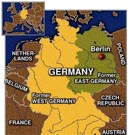Tough battle to survive for Berlin's 20,000 artists
 Berlin - Artists from all over the world have settled in Berlin, a city renowned for its liberal, free-wheeling life-style and its modestly priced apartments and studios.
Berlin - Artists from all over the world have settled in Berlin, a city renowned for its liberal, free-wheeling life-style and its modestly priced apartments and studios.
More than 20,000 are hooked into the creative arts scene. But while Berlin scores high marks as a place where life can be lived to the full, it remains a city short of cash and jobs.
"Poor but sexy," Berlin's Social Democrat mayor Klaus Wowerweit characterised it three years ago.
After World War II, it was Berlin's fate to be divided, its western half surrounded and ultimately hemmed in by the communist Wall.
Berlin's big industrial concerns switched their operations to cities like Munich, Stuttgart, Frankfurt and Dusseldorf in the Cold War years, and there was never any question of a return after the nation's unification in 1991.
The result is that Berlin has been cursed by a lack of job opportunities. So why, then, do artistically minded people gravitate to the city in such large numbers?
City tourist experts say it has to do with the richness and diversity of Berlin's cultural life, its buzzing night life, picturesque lakes and forests, and efficient public transport.
Another advantage is its size, covering an area twice that of Paris.
"Unlike most other big cities, you never feel hemmed in or restricted in Berlin," says Martin Riches, a veteran British sculptor who arrived in the late 1960s planning to stay six months. He is still here 40 years later.
"In London, Paris and New York daily life can be hectic. Getting to work sometimes proves a tiring business.
"Here it's different. You can travel from one end of Berlin to the other in relative comfort on the city's trains and buses," he says.
Berlin offers a colourful mix of cabaret, theatres and cinemas, in addition to three opera houses. But its economic viability remains fragile, with the city heavily reliant on tourism and its reputation fas a cultural jewel.
While the city remains a magnet for self-employed artists, sculptors, designers and architects they often earn less than they would in cities in western Germany, the German Institute for Economic Research (DIW) said in a recent survey.
Many have very low incomes, earning less than 700 euros (875 dollars) a month, notes the DIW. In Berlin that's barely enough to rent a medium-sized apartment, let alone support a family.
Marco Mundelius, a DIW expert, says the survey shows independent artists in Berlin earn less than half what self-employed people get in other professions.
Only in the film, radio and television were earnings "above average" for the self-employed in Berlin.
The DIW fears poverty levels are likely to increase among artists and those in other creative professions.
"Our research shows that many artists rely solely on the 'Kuenstlersozialkasse' - a German pension fund set up 30 years ago to help protect those in the arts and media.
"But as an instrument for securing members' pension requirements it's not enough," warns Mundelius.
In 2006, some 2.1 billion euros was generated by the more than 20,000 men and women working in the Berlin arts scene and by the 80,000 involved in other "creative" sectors.
As a workforce, this meant they represented 10 per cent of the city's total overall employment and economic performance, said the DIW. (dpa)